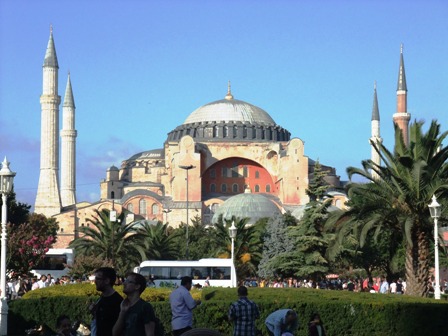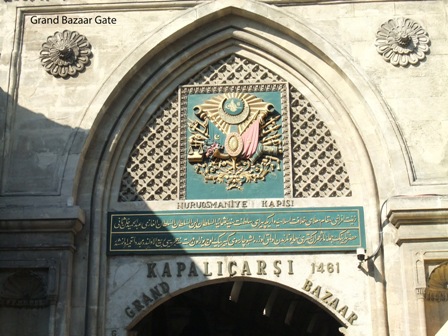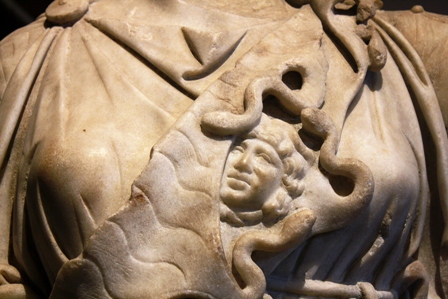Istanbul Turkey
September 2011
Click the photo above to see an album of photos for Istanbul Day 1. Close the window to return to this page.
Read next Cappadocia
|
Istanbul Turkey, Day 1, A Palace,
Mosque & Cistern
Monday 19
Sept 2011
Air
travel used to be exciting. Now it gets you to your destination faster
but it involves long security lines, extended waits between flights and
frequent delays. Nevertheless it beats overnight bus rides or trains
without comfortable berths, so we take the good with the bad. We
couldn’t think of any reason to stop along the way from Harlech to
Manchester airport with less than perfect weather, so we arrived with
more time to spare than anyone would need. The plane was late anyway but
the flight was short and uneventful. Our shuttle to the simple Heathrow
hotel we had chosen came when we called and the guesthouse staff was
friendly. They directed us to the local pub where we shared seats with a
friendly British foursome on a weekend away.
Our
flight the next morning to Istanbul was scheduled for 7:10 AM, which
means you have to be at the airport at the ungodly hourly of 5 AM. It
was too early for the hotel shuttle but they were able to deliver a good
take away breakfast at 4 AM and a free public bus was available across
the road direct to our terminal in time for our check in. Ray and I,
along with 95% of the other passengers snoozed our way to Istanbul,
making up for the early wakeup call; our drive to our hotel was there to
meet us and we met with a friendly welcome at Marmara Guesthouse. What
more can you ask?
Marmara
Guesthouse, in the Sultanahmet district, is run by a Turkish family. We
have a compact room, with an ensuite and small balcony, looking out to
another hotel. The pluses are breakfast on the roof top terrace, tea and
coffee any time of day, inexpensive beer and good travel advice. There
are lots of restaurants in the area to choose from and we are just a
short walk from most of the main. We are very comfortable.
One of
our favourite menu choices is Mezes, Turkish Tapas. Twice we have shared
a large plate of appetizer type foods displayed in glass cases in Arasta
Bazaar, just below the Blue Mosque. They were delicious. We have a new
Best Friend in one of the touts enticing customers to a restaurant on
our walking path. We finally succumbed and were both pleased with our
Turkish selections. Now we get a greeting and a hug whenever we pass.
Speaking
of touts, they are all over the area, especially encouraging us to visit
their carpet shop or look at their ceramics. So far we are on good
terms. We politely say we are not in the market and they seem to
understand and wish us a good day. It has not been an aggressive hard
sell, although there are so many shops we wonder how they ever get
enough sales to make a living.
Fellow
travellers told us they had mistakenly thought that September was
off-season for Turkey. It is not. It is still a major stop for
increasing large cruise ships and bus tours. All take in the Topkapi
Palace. So did we. There were line-ups at each of the ticket booths but
we managed to avoid the worst crushes of people. The attendant selling
audio guides advised us to visit the Harem first and he was right. We
spent over three hours on the site and were glad we had come.
Mehmet
the Conqueror built Topkapi in 1453 and subsequent sultans occupied the
compound until 1839, after which Sultans built lavish European style
palaces on the Bosphorus Sea. The public is allowed to see only a small
number of the sprawling palace buildings, but it was more than enough
for us.
Muslim
men are allowed four wives under Islamic law and sultans could have as
many concubines as they could support. Topkapi Palace housed between 300
and 500 concubines in the harem. As Islamic law forbids the enslavement
of Muslims, all the girls were foreign born, bought as slaves or
presented as gifts from nobles. The young girls were schooled in Islamic
and Turkish culture, especially music and dance, and then worked their
way up the ranks of the household hierarchy, hoping to become a
favourite of the sultan. The harem was more than the women’s quarters,
it was actually the Imperial family quarters so the rooms were numerous
and beautifully decorated. I especially loved the beautiful mosaics and
decorated domed ceilings in the rooms.
We
wandered through the rest of the buildings on the Palace grounds,
admiring the many gardens, pavilions and terraces with views over the
Sea of Marmara. We marvelled over the jewels and other antiquities and
learned about Turkey’s illustrious past. It was time well spent.
Sultanahmet Park, between the Blue Mosque and Aya Sofya, is a popular
place for locals, especially late in the day. Vendors sell roasted corn,
and fresh squeezed pomegranate or orange juice. People stop to chat and
sit on the rows of benches. We happened upon a free concert of
traditional Turkish music played by men dressed in period costume at one
end of the park late in the afternoon. A man beat enthusiastically on a
big drum, another played an eastern style wind instrument and two men
sang the melody. It looked as if dancers were waiting for their turn to
perform but we left before they came on stage. We were on our way to
visit the Basilica Cistern.
The
cistern was built by the Byzantine Emperor Justinian in 532 beneath Stoa
Basilica, a large public square, to supply the Great Palace of
Constantinople and surrounding buildings. The cistern is 65 M wide by
143 M long and once held 80,000 cu m of water fed by aqueducts from the
Belgrade forest, 19 km north of the city. The roof is supported by 336
columns with carved capitals from ruined buildings, arranged in 12 rows
with tiled domes between each group of four domes. The cistern was
forgotten until it was rediscovered in 1535 and has been restored three
times since then. We walked through the dimly lit cistern on raised
wooden platforms, beneath which swam fish clearly visible in the clear
waters. One platform led by the Teardrop Column decorated with hen’s
eyes, considered “Good Luck”, each dripping a tear. The tears pay homage
to the hundreds of slaves who died during the construction of the
cistern. Two Medusa Heads act as bases for columns. One lies upside down
while the other rests on its side. Why they were placed that way is a
subject of controversy.
The first
thing you notice when you enter the Blue Mosque is the smell of feet.
The Muslims are fastidious about washing before prayers so it must be
the thousands of tourists who have removed their shoes before walking on
the carpets that cover the floor area. The Blue Mosque, named for the
blue tiles that decorate the walls and the domed ceiling, was
constructed from 1606-1616 by Sultan Ahmet I as a rival to the nearby
Aya Sofya. Most people prefer the Aya Sofya, but the Blue Mosque is
still impressive. The public is permitted to visit the Blue Mosque
between official prayer times and allowed to admire the interior behind
a low fence separating the men’s prayer area from the public. Muslim
women were relegated to a much smaller area at the rear of the mosque.
Women have to cover their heads to enter but I noticed many taking off
their scarves as soon as they got inside. I did too for the requisite
picture taking.
We have
two more days to explore the sights of Istanbul. It will not be enough
time to see everything so we have reserved more time for our return in
October.
Istanbul Turkey Day 2 Bazaars and
Boats Click the photo above to see an album of photos for Istanbul Day 2. Close the window to return to this page. 20 Sept 2011
The
Bazaar was built by Mehmet the Conqueror in the mid 15thC as a small masonry covered
market in the heart of the Old City. A system of gates and doors were
designed so that the complex could be locked up at night. Today there
are 3000 shops inside and another 1500 shops outside selling carpets,
ceramics, silverware, copperware, lamps, leather goods, clothing...you
name it. We wandered past marble fountains still used by locals to wash
their hands and face, admiring the selection in the small crowded shops.
When I stopped to look at one piece of embroidered cloth and asked if
the shop owner had more, he led us to his cousin’s shop on another
corridor. Of course the cousin, being a good salesman, was only too
pleased to oblige. How could I resist expanding my collection of fabric
art. His bargaining was far better than mine but I am pleased with my
table runner cum wall hanging.
The Spice Market is always a favourite of ours and it was just a short walk from the Grand Bazaar. Besides colourful spices, shops sell nuts, dried fruit, Turkish Delight candies. Right across the road from the Spice Market gate is the Galata Bridge. We headed for the fabled bobbing boats dishing out fish sandwiches as fast as they could. For 5 TL ($2) we had a large fillet of fish placed between fresh crusty bread with lots of lettuce and onion. We ate it sitting on stools at a small table. It was delicious. The afternoon seemed made for a ride on a ferry. Tour boats and ferries leave from the Eminönü terminal beside the bridge taking locals and tourists into the Golden Horn waterway that leads to the Sea of Marmara and the Bosphorus. We just chose one that was ready to head off. For 2 TL we had a 20 minute ride to Üsküdar port on the quieter Eastern section. We had to look at our maps to figure out where we were. There was a nice park along the shoreline, but not much else of interest. We just wandered around for a while and took the next ferry back to our starting point and walked back to our guesthouse. Next time here we will take a ferry to another terminal and explore another district.
We had to
go to at least one Whirling Dervish performance. The easiest choice was
Cafe Meşale next to the Arasta Bazaar. Tourists come to Cafe Meşale to
sample a hookah water pipe and to watch a dervish perform a
sema, used as a meditative ceremony that represents union with god.
We didn’t try the hookah but the food was good and the
sema was interesting. I don’t think a whole evening of whirling
dervishes will be on our itinerary.
Click the photo above to see an album of photos for Istanbul Day 3. Close the window to return to this page.
21 Sept 2011
IIf you
tell me that Paris traffic is bad, or say you have been caught in
traffic jams in New York, or London, England, or even Toronto, you
haven’t seen anything until you have experienced Istanbul at rush hour.
Our
flight from Istanbul to Kayseri, in the Cappadocia region, left at 9 PM
from Sabiha Görςen Airport, 50 km E of the city. We had two choices to
get to the airport. We could either take an inexpensive 1 ½ hour shuttle
bus ride leaving at 3:30 PM. That would mean a wait of 3 hours at the
airport before we could check in at 8 PM. The alternative was a much
more expensive but shorter private taxi. That is what we booked. Since
we would be leaving near rush hour we were advised to allow 2 hours,
instead of 1 hour, to get to the airport. Our driver Emir arrived at 6
PM in his van. Emir drove up and down narrow back streets to get out of
the crowded Sultanahmet district heading for the Galata Bridge and
Eastern Istanbul. That was bad enough but it didn’t hold a candle to the
absolute grid lock we experienced on the other side. There must have
been a problem before we were caught in the traffic but we were stuck
with no avenue of escape.
Emir
called his company to find out what was going on. Nobody knew. He called
Turkish Airlines for us and found out our plane was on time and if we
didn’t get there by 8:15 we would lose the booking and have to find
another flight on our own. Finally they relented and said we had until
8:30 to reach the check-in counter. At 8 PM we reached a less busy
highway and still had 30 km to go. Emir said he was going to try to get
there by 8:30. He put on the flashers and took a restricted lane,
passing all the other cars. He wove expertly in and out of lanes. It
started to rain but we kept on. He turned off the main highway at 8:30
and started to slide on the wet pavement. We held on and he corrected in
time to make the last sprint to the departure door. It was 8:35. Emir
got out, leaving me to guard the taxi, while he and Ray ran inside to
persuade the airline to allow us to board the flight. Haleleuja! Turkish
Airlines came through. An employee came outside and collected me and our
luggage and we sprinted through security. Ray’s bag couldn’t go on as
hand luggage as the trusty Swiss Army knife was inside. All my luggage
became carry on. We boarded the plane with 10 minutes to spare. Ray said
it took 10 years off his life. Emir deserved accolades and a big tip,
but that will have to wait until we return.
And to think we thought we had an easy day. At least it started well. Ray got a haircut in the morning while I visited Turkey’s first museum, the Archaeological Museum. The collection is so vast that it becomes brain overload attempting to see everything. My favourites were the incredible detail on reliefs decorating doors and sarcophagus and the lifelike detail on the later statues of both real people and mythical men and women. Anyone with more experience with archaeology would have a field day exploring the items collected from numerous sites around Turkey and surrounding countries. I spent more than an hour browsing the exhibits and I didn’t even finish the main building let alone get to the two additional buildings on the site.
Another
must-do lunch is to sample Turkish Kebaps i.e. Shish kebabs or Donair
Kebabs. A little restaurant around the corner from the Museum had
outdoor tables and very tasty kebabs. We sat, relaxed, enjoyed our meal
and got ready for our next activity. Aya Sofya AKA Hagia Sophia is crowded with tour groups in the morning. Even the lineups to buy tickets are daunting. At 1:30 PM we could walk right in. We rented audio guides and wandered around for almost two hours. We took lots of photos of the beautiful mosaics and frescoes, admired the architecture and learned more of the history of Istanbul. Aya Sofya started life as the greatest church in Christendom when it was built by Emperor Justinian in 537 AD. Mehmet the Conqueror converted the church to a mosque 1453 and it stayed that way until 1935 when Ataturk proclaimed it a museum. Millions of admirers have toured the complex since then, including Ray and me. It lived up to its name as one of the greatest religious buildings in the world.
Return to Turkey Intro Return to Travels Return to Introduction | |||||


